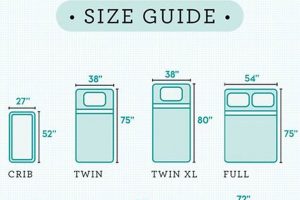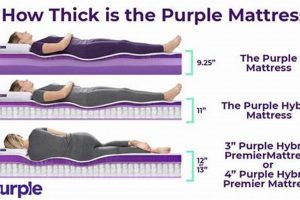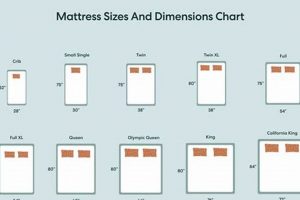The dimensions of a standard queen-sized bed frame in Canada typically measure 60 inches in width and 80 inches in length. These measurements define the sleeping surface area designed to comfortably accommodate two adults. Variations may exist depending on manufacturer and design specifics, though the stated dimensions serve as a widely accepted industry standard. Precise measurement is crucial when selecting bedding and bed frames.
Adherence to these standardized measurements offers numerous advantages. It allows for easy compatibility with readily available bedding accessories, such as sheets, comforters, and mattress protectors. Historically, the development of standard sizing has streamlined the manufacturing and retail processes, providing consumers with greater choice and consistent product expectations. This standardization also simplifies the process of replacing mattresses and coordinating furniture purchases.
The following sections will delve further into the practical implications of these dimensions for bedroom design, considerations for choosing the appropriate mattress depth, and a comparative analysis with other common mattress sizes available on the Canadian market, such as twin, full, and king. Factors influencing mattress selection beyond physical size will also be addressed.
Tips for Selecting a Queen Mattress in Canada
Choosing the correct mattress size is crucial for ensuring optimal sleep quality and bedroom functionality. The following tips provide guidance on considerations related to acquiring a queen-sized mattress within the Canadian market.
Tip 1: Confirm Bedroom Dimensions: Before purchasing, accurately measure the available space in the bedroom. Ensure adequate clearance around the perimeter of the bed frame to allow for comfortable movement and the placement of other furniture items.
Tip 2: Assess Sleep Partner Needs: A queen mattress offers more individual space compared to a full-sized mattress, potentially reducing sleep disturbance caused by a partner. Consider factors such as sleep styles and movement during the night when making a decision.
Tip 3: Review Mattress Thickness Options: Mattress thickness varies, influencing bed height and overall comfort. Take into account the height of the bed frame and personal preferences when selecting mattress depth to achieve a comfortable entry and exit.
Tip 4: Investigate Material Composition: Various mattress materials, including memory foam, innerspring, and hybrid constructions, offer different levels of support and temperature regulation. Research the benefits of each material type to identify the most suitable option based on individual needs.
Tip 5: Consider Edge Support: Strong edge support prevents sagging and maximizes the usable surface area of the mattress. This is particularly important for individuals who tend to sleep near the edge of the bed.
Tip 6: Evaluate Trial Periods and Return Policies: Many retailers offer trial periods, allowing customers to test the mattress at home and return it if dissatisfied. Thoroughly review the terms and conditions of the trial period and return policy before making a purchase.
Tip 7: Compare Pricing and Warranties: Prices for queen-sized mattresses can vary significantly based on brand, materials, and features. Compare pricing across different retailers and examine the warranty terms to ensure adequate protection against manufacturing defects.
Selecting the appropriate mattress based on dimensions, partner needs, and personal preferences is essential for a restful and supportive sleep experience. Careful consideration of the aforementioned factors will facilitate a more informed purchasing decision.
The next section will cover the various mattress types compatible with a standard queen size, focusing on materials, support systems, and overall suitability for different sleep styles and comfort preferences.
1. Standard Width (60 inches)
The 60-inch width of a standard queen mattress in Canada is a defining characteristic, directly influencing its suitability for various sleeping arrangements and room sizes. This dimension serves as a critical factor in determining the mattress’s ability to comfortably accommodate two adults or a single individual seeking ample space.
- Accommodating Two Sleepers
The 60-inch width provides approximately 30 inches of sleeping space per person, which can be sufficient for couples who do not require extensive personal space. This is particularly relevant in smaller bedrooms where maximizing available floor area is a priority. The standard width allows for a balance between shared occupancy and individual comfort.
- Bedroom Proportions and Placement
This dimension influences how the mattress integrates into the room’s overall layout. The 60-inch width, combined with the standard 80-inch length, dictates the amount of floor space occupied. Planning furniture placement and traffic flow requires precise consideration of these dimensions to avoid overcrowding or obstruction.
- Bedding and Accessory Compatibility
The standardized width ensures compatibility with commonly available bedding products, such as sheets, comforters, and mattress protectors. Purchasing these items is simplified by the uniform dimensions, allowing consumers to easily find appropriately sized accessories. Non-standard widths would necessitate custom or specialized bedding.
- Comparison with Other Mattress Sizes
The 60-inch width provides a clear differentiation from full-sized mattresses (typically 54 inches wide) and king-sized mattresses (typically 76 inches wide). This distinction guides consumers in selecting a mattress that best suits their individual needs and available space. The queen size represents a middle ground, offering more room than a full but requiring less space than a king.
The standard 60-inch width is integral to the definition and practical application of a queen mattress in Canada. It directly impacts the sleeping experience, bedroom design, and the ease of purchasing related accessories. Understanding the implications of this dimension is essential for making an informed decision when selecting a mattress.
2. Standard Length (80 inches)
The 80-inch standard length is a fundamental component defining the size parameters of a queen mattress in Canada. This dimension, in conjunction with the 60-inch width, establishes the rectangular surface area intended for sleeping. Its importance is multifaceted, influencing comfort, compatibility with bed frames and bedding, and the overall suitability of the mattress for individuals and couples.
- Accommodation of Height
The 80-inch length primarily caters to the height requirements of most adults. This dimension is generally sufficient for individuals up to approximately 6 feet 6 inches tall, providing adequate legroom and preventing discomfort caused by protruding feet. The standard length helps ensure that the mattress is ergonomically appropriate for a significant portion of the population.
- Bed Frame and Foundation Compatibility
Adherence to the 80-inch standard facilitates seamless integration with bed frames and foundations specifically designed for queen-sized mattresses. This ensures a secure and stable platform for the mattress, preventing shifting or misalignment. Discrepancies in length can lead to inadequate support and potential damage to both the mattress and the bed frame.
- Bedding Dimensions and Fit
The established length allows for the production and widespread availability of bedding accessories, such as sheets, comforters, and duvet covers, that are appropriately sized for queen mattresses. Standardized bedding dimensions guarantee a snug fit, enhancing both the aesthetic appeal and the functional performance of the bed. Ill-fitting bedding can detract from the overall comfort and appearance.
- Impact on Bedroom Layout
The 80-inch length contributes significantly to the overall footprint of the mattress and bed within the bedroom. Careful consideration of this dimension is essential for planning furniture placement and ensuring adequate space for movement. In smaller bedrooms, the length of the mattress can be a critical factor in determining the practicality of accommodating a queen-sized bed.
The 80-inch standard length, therefore, is not merely a measurement but a crucial factor affecting the practical application and overall satisfaction derived from a queen-sized mattress in the Canadian context. It ensures compatibility with frames and bedding, provides adequate space for most adults, and impacts room layout considerations.
3. Thickness Variability
The thickness of a queen mattress, while not explicitly part of the 60-inch by 80-inch dimensional standard in Canada, is a critical variable influencing comfort, support, and overall bed height. Variability in thickness impacts purchasing decisions and the functional integration of the mattress within a bedroom setting.
- Impact on Support and Comfort
Mattress thickness directly correlates with the amount and type of materials used in its construction. Thicker mattresses often incorporate more layers of comfort materials, such as memory foam or latex, and potentially more robust support cores, such as innerspring systems or high-density foams. This increased material volume can lead to enhanced pressure relief, improved spinal alignment, and a more luxurious sleeping experience. A thinner mattress may lack the necessary support for certain individuals, particularly those with specific orthopedic needs or higher body weights.
- Bed Height and Accessibility
Mattress thickness significantly affects the overall height of the bed. The combined height of the bed frame, foundation (if used), and mattress determines how easy it is to get in and out of bed. Individuals with mobility issues or those who prefer a higher or lower bed profile must carefully consider mattress thickness to achieve a comfortable and accessible sleeping arrangement. Excessive mattress thickness on an already tall bed frame can create an uncomfortably high sleeping surface.
- Compatibility with Bedding and Accessories
While standardized in width and length, bedding designed for queen mattresses may not always accommodate extreme variations in thickness. Deep-pocket sheets are often required for thicker mattresses to ensure a secure and proper fit. Additionally, the selection of bed skirts and other decorative accessories may be limited by the mattress’s thickness. Consideration of these factors is essential to ensure seamless integration of the mattress with existing or planned bedding sets.
- Aesthetic Considerations and Room Proportions
Mattress thickness contributes to the visual proportions of the bed within the bedroom. An excessively thick mattress on a low-profile bed frame might appear disproportionate, while a very thin mattress on a tall bed frame could look underwhelming. Coordinating mattress thickness with the style and scale of the bed frame and the overall dimensions of the room is crucial for achieving a balanced and aesthetically pleasing bedroom design.
Thickness variability, therefore, interacts with the standardized width and length dimensions to define the practical attributes of a queen mattress. It influences comfort, accessibility, bedding compatibility, and the aesthetic integration of the bed within a bedroom space. While the physical dimensions of width and length remain constant, the variable of thickness introduces an additional layer of complexity in the selection process.
4. Bed Frame Compatibility
Ensuring correct bed frame compatibility with standardized queen mattress dimensions within the Canadian market is paramount. Deviations can lead to compromised support, reduced sleep quality, and potential safety hazards. The following outlines critical aspects of this compatibility.
- Precise Dimensional Matching
Bed frames designed for queen-sized mattresses are engineered to precisely accommodate the standard 60-inch by 80-inch dimensions. Slight discrepancies, even fractions of an inch, can result in a mattress that either sags due to insufficient support or is too tightly compressed, leading to premature wear. Inspecting frame dimensions prior to purchase is crucial. Example: A platform bed designed for a queen mattress must have internal dimensions mirroring these standards to prevent overhang or instability.
- Support Structure Integrity
The bed frame’s support structure, whether consisting of slats, a solid platform, or a box spring, must be adequate to evenly distribute the weight of the mattress and occupants. Insufficient or improperly spaced slats, for instance, can cause the mattress to deform over time, leading to discomfort and reducing its lifespan. The number and spacing of slats should adhere to manufacturer recommendations to ensure optimal support. An example would be a slat system with gaps wider than 3 inches which may allow for mattress sagging between the supports.
- Headboard and Footboard Attachment
Queen-sized bed frames often feature integrated headboards and footboards. Compatibility extends to the proper alignment of attachment points and overall stability of the assembled unit. Misaligned attachments can result in structural weakness or an aesthetically displeasing appearance. Verifying that the headboard and footboard are specifically designed for queen-sized frames is essential. For example, using a full-size headboard on a queen-size frame will expose unsupported areas and look aesthetically unbalanced.
- Rail and Siderail Engagement
The engagement of siderails with the headboard and footboard is vital for the frame’s structural integrity. Secure and properly aligned rails prevent lateral movement and ensure the mattress remains centered within the frame. Loose or improperly attached siderails can compromise the bed’s stability and create potential safety risks. Check the locking mechanism of the siderails with the headboard and footboard is properly secure.
These elements underscore the critical relationship between bed frame selection and the established size standards for queen mattresses in Canada. Deviation from dimensional specifications or inadequate support structures can lead to compromised sleep quality and diminished mattress longevity. Adhering to compatibility guidelines ensures optimal performance and safety.
5. Bedroom Space
The size of a queen mattress in Canada, with its standard dimensions of 60 inches by 80 inches, has a direct and considerable impact on bedroom space utilization. The relationship is one of cause and effect: the fixed dimensions of the mattress dictate the minimum area required within a room to accommodate it comfortably. Limited bedroom space often necessitates careful consideration of furniture placement and overall room layout, directly influencing the choice of mattress size. For instance, smaller bedrooms may struggle to accommodate a queen mattress without compromising walkability and accessibility to other furnishings, potentially necessitating a smaller full-sized mattress.
Bedroom space is a crucial component when considering mattress dimensions, affecting not only physical accessibility but also the overall aesthetic and functional flow of the room. A too-large mattress in a small room can create a sense of confinement and disrupt the room’s proportions, while an appropriately sized mattress allows for adequate circulation and enhances the room’s visual appeal. Consider a bedroom measuring 10 feet by 12 feet: a queen mattress would occupy a substantial portion of the floor area, leaving approximately 5 feet of space on either side for movement and furniture. In contrast, a larger 12 feet by 14 feet room provides greater flexibility in furniture arrangement and accommodates the queen mattress more seamlessly. This choice is not merely aesthetic; it has a direct impact on the user’s daily life and the functionality of the living space.
In conclusion, the interplay between bedroom dimensions and mattress size is fundamental to effective interior design and comfortable living. The standard dimensions of a queen mattress in Canada impose spatial requirements that must be carefully considered when planning a bedroom layout. Challenges arise when pre-existing space constraints limit mattress choices, necessitating compromises in comfort or aesthetics. By understanding the spatial implications of mattress size, individuals can make informed decisions to optimize their living environment, balancing comfort, functionality, and visual harmony. This awareness is integral to selecting a mattress that fits not only personal preferences but also the physical constraints of the available space.
Frequently Asked Questions
This section addresses commonly encountered inquiries regarding the dimensions and associated considerations for queen-sized mattresses available in Canada. The aim is to provide concise and accurate information to assist in informed decision-making.
Question 1: What are the standard dimensions of a queen mattress in Canada?
The generally accepted standard dimensions are 60 inches in width and 80 inches in length. These dimensions may vary slightly between manufacturers, but the aforementioned measurements serve as a common benchmark.
Question 2: Does the thickness of a queen mattress affect its compatibility with queen-sized bed frames?
While the width and length determine primary compatibility, thickness can influence the overall bed height and the suitability of bedding accessories. Deep-pocket sheets may be required for thicker mattresses. Bed frames should generally accommodate a range of standard thicknesses.
Question 3: How does the size of a queen mattress compare to a full or double mattress?
A queen mattress is wider and longer than a full or double mattress. A full mattress typically measures 54 inches in width and 75 inches in length, making the queen a larger option suitable for couples or individuals seeking more space.
Question 4: What is the recommended bedroom size for comfortably accommodating a queen mattress?
A minimum bedroom size of 10 feet by 10 feet is generally recommended, although larger rooms allow for greater flexibility in furniture placement and movement. This ensures sufficient space for the bed and additional furnishings without overcrowding.
Question 5: Are all queen mattresses manufactured to precisely the same dimensions in Canada?
While the 60-inch by 80-inch dimensions represent the industry standard, slight variations may occur due to manufacturing tolerances. Consumers are advised to verify the exact dimensions with the retailer or manufacturer before purchasing.
Question 6: What factors beyond size should be considered when selecting a queen mattress?
Beyond dimensions, considerations should include mattress material, firmness level, support system, temperature regulation properties, edge support, and warranty coverage. Individual sleep preferences and physical requirements should guide the selection process.
Understanding these dimensions and associated factors is essential for selecting a queen mattress that provides adequate comfort, support, and compatibility within the intended bedroom space.
The subsequent section will discuss the different types of materials used in queen mattresses and their impact on sleep quality.
Size of Queen Mattress Canada
This document has outlined the critical dimensions associated with a standard queen mattress within the Canadian market. Precise measurements of 60 inches in width and 80 inches in length dictate compatibility with bed frames, bedding accessories, and the overall suitability for various bedroom configurations. Thickness variability, support structures, and material compositions have also been examined to provide a holistic understanding of factors influencing the selection process.
Given the significant impact of mattress size on sleep quality and bedroom functionality, accurate assessment of spatial constraints and adherence to standardized dimensions are paramount. Future advancements in mattress technology and material science may introduce subtle variations in design, yet the core dimensions outlined herein remain fundamental. Consumers are urged to prioritize informed decision-making, consulting manufacturer specifications and expert guidance to ensure optimal comfort and long-term satisfaction with their investment.



![Best Queen Size Foldable Mattress [Guide] Organic & Natural Mattress Buyer’s Guide: Non-Toxic Sleep Solutions Best Queen Size Foldable Mattress [Guide] | Organic & Natural Mattress Buyer’s Guide: Non-Toxic Sleep Solutions](https://mattressworldpa.com/wp-content/uploads/2025/07/th-2272-300x200.jpg)


![Best Queen Size Floor Mattress [Guide] Organic & Natural Mattress Buyer’s Guide: Non-Toxic Sleep Solutions Best Queen Size Floor Mattress [Guide] | Organic & Natural Mattress Buyer’s Guide: Non-Toxic Sleep Solutions](https://mattressworldpa.com/wp-content/uploads/2025/07/th-2269-300x200.jpg)
